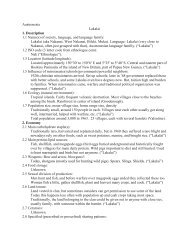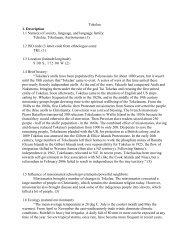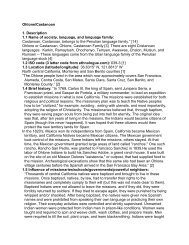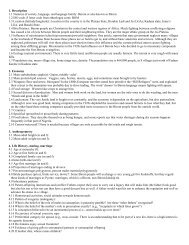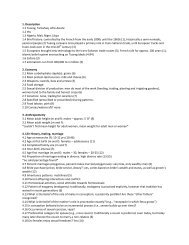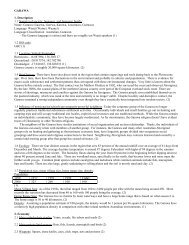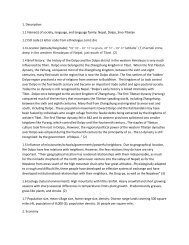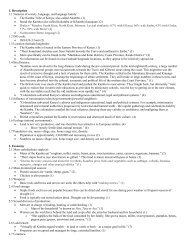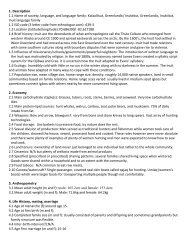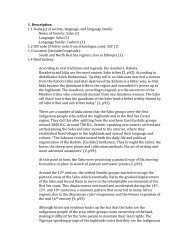Yoruba
Yoruba
Yoruba
You also want an ePaper? Increase the reach of your titles
YUMPU automatically turns print PDFs into web optimized ePapers that Google loves.
1.5 Influence of missionaries/schools/governments/powerful neighbors:<br />
- Missionaries begin coming to <strong>Yoruba</strong>land around the 1840s. Their influence<br />
was great, since it is through them that literacy is introduced (Biobaku 1-3). It is<br />
from these missionaries we get early accounts of <strong>Yoruba</strong> history. For example,<br />
Dr. Irving in the 1840s interviewed many people regarding the devastation of<br />
Egbaland (Biobaku 15-16).<br />
1.6 Ecology (natural environment):<br />
- <strong>Yoruba</strong>land falls in 3 different physical environments:<br />
The coastal zone “about 12 miles wide, raised only slightly above sea level,<br />
consists of peninsulas, islands, sandbanks, lagoons and swamps. The surface<br />
is composed of marine and river sand with alluvium and decaying vegetable<br />
matter and the whole area is more or less covered with aquatic plants,<br />
mangrove and forest vegetation” (Forde 5).<br />
The plain “about 40 miles wide, ends inland a little south of Abeokuta and<br />
Ondo, where it has risen to about 650 feet. There are extensive deposits of<br />
red clayey and mainly unstrained sand, known as Benin sand. This zone is in<br />
the rainforest belt, and iroko oil bean, rubber, Mahoney, silk, cotton and<br />
other tress are found. There is some open parkland among the forest” (Forde<br />
5).<br />
The Interior Plateau “rising to height of 500-1200 ft., consists of dissected<br />
granitic. The deciduous trees appear and gradually increase northwards<br />
ending in a forest which, further north, thins out considerably and is replaced<br />
by tall grass” (Forde 5).<br />
1.7 Population size, mean village size, home range size, density<br />
The <strong>Yoruba</strong> population is the most urban of all Africans. In the 1931 census<br />
holds population at about 3,116,164 (Forde 3). In the Southern province there is<br />
2,667,164, with Oyo with the population of 1,332,843, Abeoketu 434,410, Ondo<br />
381,013, Ijebu 305,568, Colony 205,563, Owerri 3,346, Onitsha 2,099, Benin<br />
2,055, Calabar 824, Ogoja 195, Cameroons 35. In the Northern province the<br />
population is 498,212, with Cercle of Porto-Nova at 90,000, Ketu 10,028, Cercle<br />
of Savalou 55,566, in French Togo land 13,000 (Forde 3).<br />
2. Economy<br />
The economy of the <strong>Yoruba</strong> circles around agriculture, cocoa farming, palm<br />
products, crafts, and trade (Forde 6-10). Each village can specialize in a certain area.<br />
2.1 Main carbohydrate staple(s):<br />
Yams, maze, bananas, pumpkins, peppers, nuts and kernels (Forde 6).<br />
2.2 Main protein-lipid sources:<br />
Sheep, chickens, guinea fowls, ducks, turkeys, black goats, pigs, beans and<br />
palm oil (Forde 6).<br />
2.3 Weapons: Bow and arrow, blowguns:



